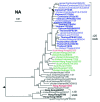Evolution of H5N1 avian influenza viruses in Asia
- PMID: 16318689
- PMCID: PMC3366754
- DOI: 10.3201/eid1110.050644
Evolution of H5N1 avian influenza viruses in Asia
Abstract
An outbreak of highly pathogenic avian influenza A (H5N1) has recently spread to poultry in 9 Asian countries. H5N1 infections have caused > or =52 human deaths in Vietnam, Thailand, and Cambodia from January 2004 to April 2005. Genomic analyses of H5N1 isolates from birds and humans showed 2 distinct clades with a nonoverlapping geographic distribution. All the viral genes were of avian influenza origin, which indicates absence of reassortment with human influenza viruses. All human H5N1 isolates tested belonged to a single clade and were resistant to the adamantane drugs but sensitive to neuraminidase inhibitors. Most H5N1 isolates from humans were antigenically homogeneous and distinct from avian viruses circulating before the end of 2003. Some 2005 isolates showed evidence of antigenic drift. An updated nonpathogenic H5N1 reference virus, lacking the polybasic cleavage site in the hemagglutinin gene, was produced by reverse genetics in anticipation of the possible need to vaccinate humans.
Figures


Similar articles
-
Genetic analysis of avian influenza A viruses isolated from domestic waterfowl in live-bird markets of Hanoi, Vietnam, preceding fatal H5N1 human infections in 2004.Arch Virol. 2009;154(8):1249-61. doi: 10.1007/s00705-009-0429-2. Epub 2009 Jul 4. Arch Virol. 2009. PMID: 19578928
-
Molecular characterization of the hemagglutinin and neuraminidase genes of H5N1 influenza A viruses isolated from poultry in Vietnam from 2004 to 2005.J Vet Med Sci. 2006 May;68(5):527-31. doi: 10.1292/jvms.68.527. J Vet Med Sci. 2006. PMID: 16757902
-
Challenges for accurate and prompt molecular diagnosis of clades of highly pathogenic avian influenza H5N1 viruses emerging in Vietnam.Avian Pathol. 2012;41(2):177-93. doi: 10.1080/03079457.2012.656578. Avian Pathol. 2012. PMID: 22515536
-
[H5N1 avian influenza].Recenti Prog Med. 2005 Nov;96(11):523-34. Recenti Prog Med. 2005. PMID: 16499158 Review. Italian.
-
Epidemiology, ecology and gene pool of influenza A virus in Egypt: will Egypt be the epicentre of the next influenza pandemic?Virulence. 2015;6(1):6-18. doi: 10.4161/21505594.2014.992662. Virulence. 2015. PMID: 25635701 Free PMC article. Review.
Cited by
-
Vaccination with Astragalus and Ginseng Polysaccharides Improves Immune Response of Chickens against H5N1 Avian Influenza Virus.Biomed Res Int. 2016;2016:1510264. doi: 10.1155/2016/1510264. Epub 2016 Aug 15. Biomed Res Int. 2016. PMID: 27597953 Free PMC article.
-
Matrix protein 2 vaccination and protection against influenza viruses, including subtype H5N1.Emerg Infect Dis. 2007 Mar;13(3):426-35. doi: 10.3201/eid1303.061125. Emerg Infect Dis. 2007. PMID: 17552096 Free PMC article.
-
A real-time RT-PCR for detection of clade 1 and 2 H5N1 influenza A virus using locked nucleic acid (LNA) TaqMan probes.Virol J. 2010 Feb 22;7:46. doi: 10.1186/1743-422X-7-46. Virol J. 2010. PMID: 20170549 Free PMC article.
-
A systemic review on medicinal plants and their bioactive constituents against avian influenza and further confirmation through in-silico analysis.Heliyon. 2023 Mar 10;9(3):e14386. doi: 10.1016/j.heliyon.2023.e14386. eCollection 2023 Mar. Heliyon. 2023. PMID: 36925514 Free PMC article. Review.
-
Natural variation can significantly alter the sensitivity of influenza A (H5N1) viruses to oseltamivir.Antimicrob Agents Chemother. 2006 Nov;50(11):3809-15. doi: 10.1128/AAC.00645-06. Epub 2006 Aug 28. Antimicrob Agents Chemother. 2006. PMID: 16940075 Free PMC article.
References
-
- World Health Organization. Confirmed human cases of avian influenza A(H5N1) since 28 January 2004. [on the Internet]. 2005 Jan 26 [cited 2005 Aug 1]. Available from http://www.who.int/csr/disease/avian_influenza/country/cases_table_2005_...
Publication types
MeSH terms
Substances
Grants and funding
LinkOut - more resources
Full Text Sources
Other Literature Sources
Medical
Miscellaneous
